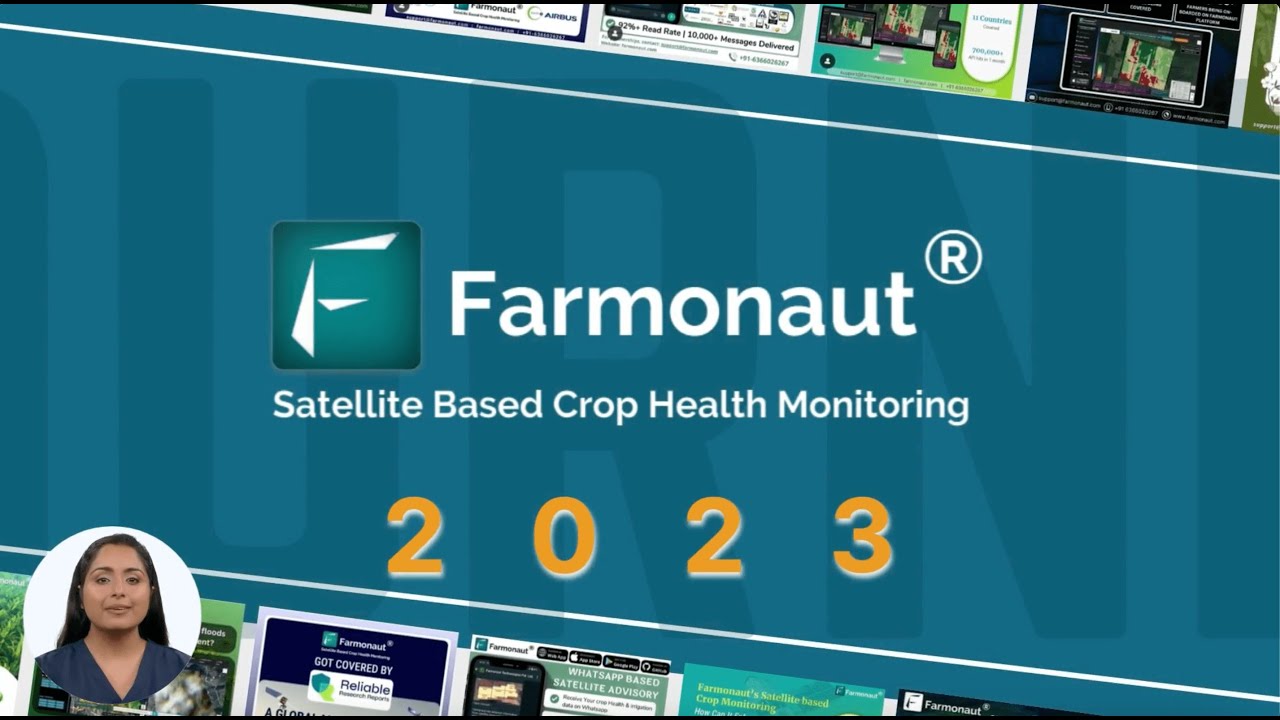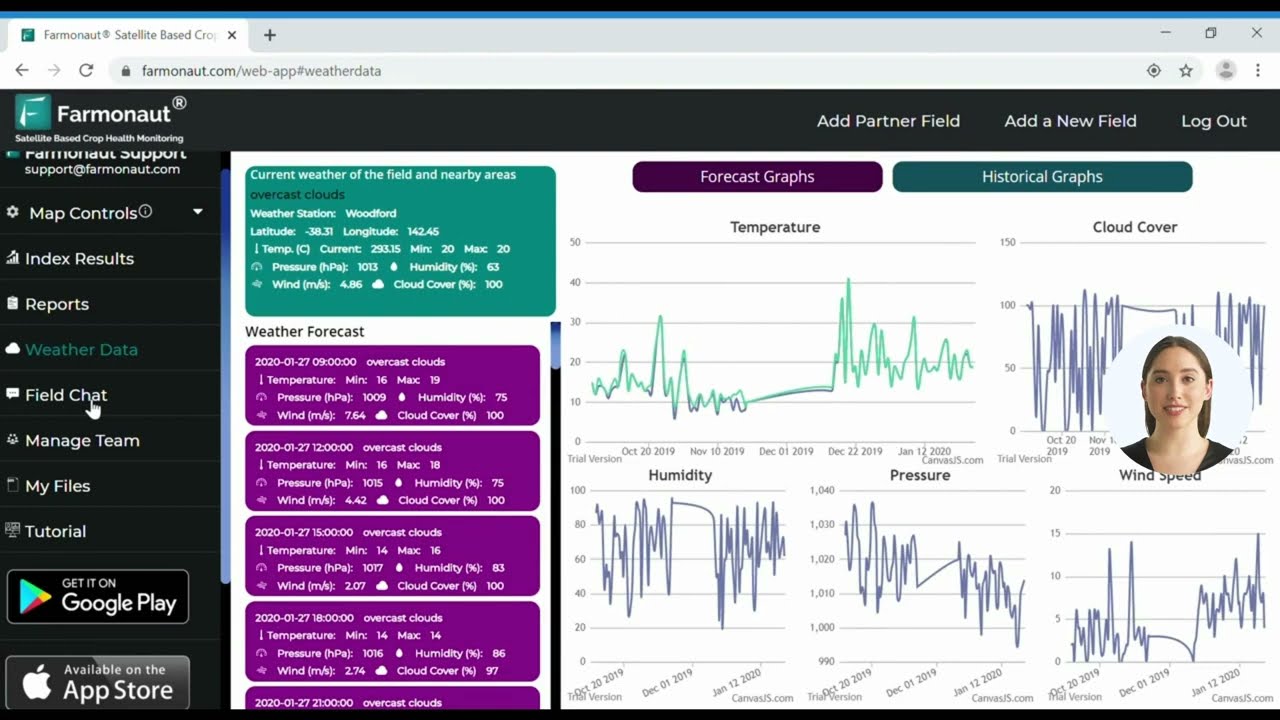Revolutionizing Plant Health Management: How Australia’s Digital Systems Are Transforming Agricultural Biosecurity
“Australia’s agricultural biosecurity initiatives involve partnerships across government, corporate, and community sectors, impacting millions of hectares nationwide.”
In the vast landscape of Australian agriculture, we’re witnessing a remarkable transformation in how we approach plant health management and biosecurity. As representatives of Farmonaut, a leading agricultural technology company, we’re excited to explore the innovative digital systems that are reshaping the agricultural sector across the continent. From the bustling farms of Queensland to the expansive fields of Western Australia, a revolution is underway, and we’re here to guide you through it.
The Digital Dawn in Australian Agriculture
Australia’s agricultural industry has long been a cornerstone of the nation’s economy, but it faces ongoing challenges from pests, diseases, and changing climate patterns. In response, we’ve seen a surge in the development and implementation of digital systems designed to enhance plant health management and strengthen agricultural biosecurity. These innovations are not just changing the way we farm; they’re transforming how we protect our crops and secure our food supply for generations to come.

At Farmonaut, we’re proud to be part of this digital revolution. Our satellite-based farm management solutions are helping farmers across Australia monitor crop health, optimize resource use, and make data-driven decisions. But we’re just one piece of a much larger puzzle. Let’s dive into how Australia is leveraging technology to create a more resilient and sustainable agricultural sector.
The Pillars of Plant Health Management in Australia
Australia’s approach to plant health management is built on several key pillars:
- Early Detection and Rapid Response: Digital systems are enhancing our ability to identify and respond to pest incursions quickly.
- Data-Driven Decision Making: Advanced analytics and AI are providing farmers and policymakers with actionable insights.
- Collaborative Networks: Digital platforms are fostering stronger partnerships between government agencies, research institutions, and farmers.
- Sustainable Practices: Technology is enabling more efficient resource use and environmentally friendly farming methods.
These pillars form the foundation of Australia’s digital approach to agricultural biosecurity, creating a robust framework for protecting our crops and ecosystems.
Innovative Digital Systems Transforming Australian Agriculture
Let’s explore some of the groundbreaking digital systems that are making waves across Australia’s agricultural landscape:
1. National Plant Health Surveillance System
This comprehensive system integrates data from various sources, including satellite imagery, ground-based sensors, and field reports. It provides real-time monitoring of plant health across the country, enabling early detection of potential threats.
2. Biosecurity Information Management System (BIMS)
BIMS is a centralized platform that facilitates information sharing between different stakeholders in the biosecurity sector. It streamlines the process of reporting, tracking, and managing biosecurity incidents across Australia.
3. Digital Pest Identification Tools
Advanced image recognition technology and AI-powered apps are helping farmers and biosecurity officers quickly identify pests and diseases in the field. These tools are crucial for rapid response and containment strategies.
At Farmonaut, we understand the importance of accurate pest identification. Our satellite-based crop monitoring system can detect early signs of pest infestation, allowing farmers to take proactive measures. To learn more about our services, check out our web app or download our mobile apps:
4. Agricultural Risk Management Platforms
These platforms use predictive analytics to assess and manage risks associated with climate variability, market fluctuations, and pest outbreaks. They help farmers make informed decisions about crop selection, planting times, and resource allocation.
5. Blockchain-Based Traceability Systems
Blockchain technology is being used to create transparent and tamper-proof supply chains. This enhances food safety, reduces fraud, and allows consumers to trace their food from farm to table.
“Digital plant health management systems in Australia are addressing biosecurity challenges for over 85,000 farms across the continent.”
The Impact of Digital Systems on Australian Agriculture
The adoption of these digital systems is having a profound impact on Australian agriculture:
- Improved Productivity: Precision agriculture techniques enabled by digital systems are increasing crop yields and reducing input costs.
- Enhanced Biosecurity: Early detection and rapid response capabilities are minimizing the impact of pest incursions.
- Sustainable Practices: Data-driven decisions are leading to more efficient use of water, fertilizers, and pesticides.
- Market Access: Improved traceability and quality assurance are opening up new export opportunities for Australian produce.

Farmonaut’s Role in Australia’s Digital Agricultural Landscape
As a pioneer in agricultural technology, Farmonaut is proud to contribute to Australia’s digital transformation in agriculture. Our satellite-based solutions offer:
- Real-time Crop Health Monitoring: Our advanced NDVI (Normalized Difference Vegetation Index) analysis helps farmers track crop health and detect issues early.
- AI-Driven Recommendations: Our Jeevn AI system provides personalized advice to farmers, helping them optimize their operations.
- Resource Management Tools: We offer solutions for efficient water management and fertilizer application, promoting sustainable farming practices.
To explore how Farmonaut can benefit your farm or agribusiness, visit our web app or check out our API services:
Farmonaut API |
API Developer Docs
Challenges and Future Directions
While the progress in digital agricultural systems is impressive, challenges remain:
- Digital Literacy: Ensuring all farmers can effectively use these new technologies.
- Data Privacy and Security: Protecting sensitive farm data from cyber threats.
- Infrastructure: Improving internet connectivity in rural areas to support digital agriculture.
- Integration: Ensuring different systems can work together seamlessly.
Looking ahead, we anticipate further advancements in:
- AI and Machine Learning: More sophisticated predictive models for pest outbreaks and crop yields.
- Internet of Things (IoT): Greater adoption of smart sensors and automated farm equipment.
- Remote Sensing: Higher resolution satellite and drone imagery for even more precise farm management.
Australian Agricultural Biosecurity Digital Systems Comparison
| Digital System Name | Primary Function | Geographic Coverage | Key Features | Stakeholders Involved | Estimated Impact on Biosecurity | Integration with Farmonaut Services |
|---|---|---|---|---|---|---|
| AUSPestCheck | Pest Detection and Reporting | National | Real-time pest mapping, Mobile app for field reporting | Farmers, Biosecurity Officers, Researchers | High | Complementary – Farmonaut data enhances pest risk assessment |
| FeralScan | Invasive Species Monitoring | National | Community-driven data collection, Species-specific modules | Community members, Land managers, Government agencies | Medium | Potential for data integration with Farmonaut’s satellite imagery |
| MyPestGuide Reporter | Pest Identification and Reporting | Western Australia (Primary focus) | Image-based pest identification, Expert verification system | Farmers, Gardeners, Biosecurity experts | Medium | Farmonaut’s AI could enhance identification accuracy |
| GrowNotes Alert | Crop Health Alerts | National | Customized alerts, Weather-based risk forecasting | Grain growers, Agronomists | Medium-High | Farmonaut’s satellite data could improve alert precision |
| BioSecure HACCP | Biosecurity Management for Nurseries | National | Risk assessment tools, Certification program | Nursery operators, Regulators | High | Farmonaut’s resource management tools could complement operations |
| PlantPlan | Emergency Response Coordination | National | Incident management system, Resource allocation tools | Government agencies, Emergency responders | High | Farmonaut’s real-time data could aid in response planning |
The Role of Training and Education
As we continue to advance our digital agricultural systems, training and education play a crucial role in ensuring their effective implementation. Australia has developed comprehensive biosecurity training programs that cover various aspects of plant health management:
- Online Courses: Interactive e-learning modules on pest identification, biosecurity protocols, and digital tool usage.
- Simulation Exercises: Virtual scenarios that prepare stakeholders for real-world biosecurity emergencies.
- Workshops and Seminars: Regular events that bring together experts to share knowledge and best practices.
- Field Days: Practical demonstrations of new technologies and techniques in real farm settings.
These training initiatives are essential for building a skilled workforce capable of leveraging digital systems to their full potential. They also foster a culture of biosecurity awareness across the agricultural sector.
The Economic Impact of Digital Agricultural Systems
The adoption of digital systems in Australian agriculture is not just a technological shift; it’s an economic game-changer. Let’s explore the financial implications:
- Cost Savings: Precision agriculture techniques enabled by digital systems can significantly reduce input costs for farmers. For example, targeted fertilizer application guided by satellite data can lead to savings of up to 30% on fertilizer expenses.
- Productivity Gains: Early pest detection and efficient resource management can increase crop yields by 10-15%, translating to substantial revenue increases for farmers.
- Market Access: Improved traceability and quality assurance through digital systems are opening up premium markets for Australian produce, both domestically and internationally.
- Risk Mitigation: Advanced forecasting and risk management tools are helping farmers and insurers better manage agricultural risks, potentially leading to more favorable insurance terms for farmers.
While the initial investment in digital systems can be significant, the long-term economic benefits for individual farmers and the broader agricultural sector are substantial. Government initiatives and public-private partnerships are helping to offset some of the upfront costs, making these technologies more accessible to farmers of all scales.
Case Study: Digital Transformation in Queensland’s Horticultural Sector
Queensland, known for its diverse horticultural production, has been at the forefront of adopting digital agricultural systems. Here’s a glimpse into how this transformation is unfolding:
- Smart Irrigation Systems: Citrus growers in the Burnett region have implemented IoT-enabled irrigation systems, resulting in water savings of up to 20% and improved fruit quality.
- Drone Technology: Macadamia farmers in the Bundaberg area are using drones for early detection of pests and diseases, allowing for targeted treatments and reducing overall pesticide use by 15%.
- Supply Chain Digitization: The state’s mango industry has adopted blockchain-based traceability systems, enhancing food safety and opening up new export markets in Asia.
These initiatives demonstrate how digital systems are not only improving farm operations but also strengthening the entire agricultural value chain.
The Future of Plant Health Management in Australia
As we look to the future, several trends are likely to shape the evolution of plant health management and agricultural biosecurity in Australia:
- Increased Automation: We anticipate greater adoption of autonomous vehicles and robots for tasks like pest monitoring and precision spraying.
- Advanced Analytics: Machine learning algorithms will become more sophisticated, offering even more accurate predictions and insights for farm management.
- Integration of Diverse Data Sources: Systems will increasingly combine data from satellites, ground sensors, weather stations, and even social media to provide a comprehensive view of agricultural landscapes.
- Biotechnology Advancements: Gene editing technologies like CRISPR may be integrated with digital systems to develop more resilient crop varieties.
- Climate Adaptation: Digital systems will play a crucial role in helping farmers adapt to changing climate patterns, optimizing crop choices and farming practices for new conditions.
At Farmonaut, we’re excited to be part of this ongoing revolution. Our commitment to innovation and sustainability drives us to continually enhance our satellite-based solutions, ensuring that Australian farmers have access to the most advanced tools for plant health management.
Conclusion: A Digital Future for Australian Agriculture
The transformation of Australia’s agricultural sector through digital systems is a testament to the country’s innovative spirit and commitment to sustainable farming practices. From the vast cattle stations of the Northern Territory to the vineyards of Victoria, digital technologies are reshaping how we approach plant health management and biosecurity.
As we’ve explored in this article, these digital systems are not just improving productivity and efficiency; they’re fundamentally changing the way we interact with our agricultural landscapes. They’re enabling us to be more proactive in pest management, more precise in our resource use, and more connected across the entire agricultural value chain.
At Farmonaut, we’re proud to be contributing to this digital revolution. Our satellite-based solutions are helping farmers across Australia make data-driven decisions, optimize their operations, and build more resilient agricultural businesses. As we look to the future, we’re committed to continuing our innovation, working alongside farmers, researchers, and policymakers to create a more sustainable and productive agricultural sector.
The journey towards a fully digitized agricultural sector is ongoing, and challenges remain. But with continued investment in research, infrastructure, and education, Australia is well-positioned to lead the world in smart, sustainable agriculture. The digital systems we’re implementing today are laying the foundation for a future where our farms are not just more productive, but also more resilient to the challenges of a changing climate and growing global demand for food.
As we conclude, we invite you to be part of this exciting transformation. Whether you’re a farmer looking to adopt new technologies, a researcher exploring innovative solutions, or simply someone interested in the future of agriculture, there’s a role for you in this digital revolution. Together, we can build an agricultural sector that’s not only more productive and sustainable but also more inclusive and resilient.
To learn more about how Farmonaut can support your agricultural endeavors, visit our web app or explore our mobile applications. Let’s cultivate a smarter, more sustainable future for Australian agriculture together.
Frequently Asked Questions (FAQ)
- What are the main benefits of digital systems in Australian agriculture?
Digital systems improve productivity, enhance biosecurity measures, promote sustainable practices, and open up new market opportunities through improved traceability and quality assurance. - How are digital systems helping with pest management in Australia?
Digital systems enable early detection of pests through satellite imagery and AI-powered identification tools, allowing for rapid response and targeted treatment strategies. - What role does Farmonaut play in Australia’s agricultural digital transformation?
Farmonaut provides satellite-based farm management solutions that help farmers monitor crop health, optimize resource use, and make data-driven decisions. - How are farmers being trained to use these new digital systems?
Training initiatives include online courses, simulation exercises, workshops, and field days that provide hands-on experience with new technologies. - What are the main challenges in implementing digital agricultural systems in Australia?
Key challenges include improving digital literacy among farmers, ensuring data privacy and security, enhancing rural internet connectivity, and integrating various systems effectively. - How are digital systems impacting the economics of farming in Australia?
Digital systems are leading to cost savings through more efficient resource use, productivity gains from better management practices, and increased market access through improved traceability. - What future developments can we expect in digital agricultural systems?
Future developments may include greater automation, more advanced AI and machine learning applications, integration of diverse data sources, and systems to help farmers adapt to climate change.



















